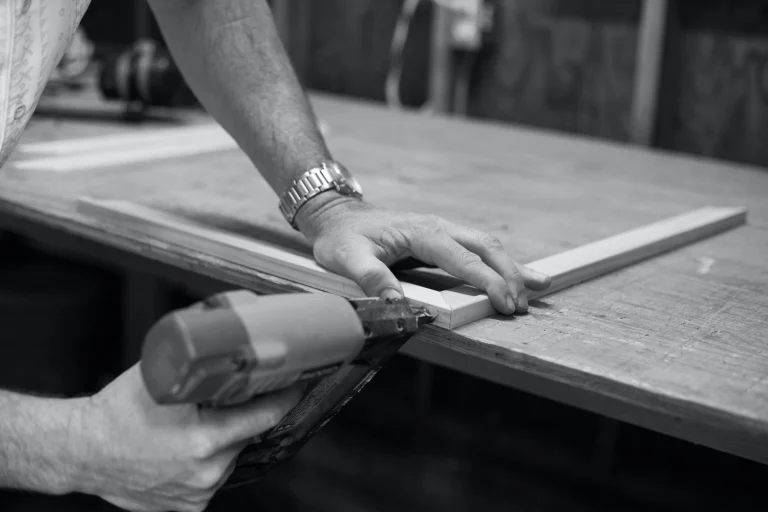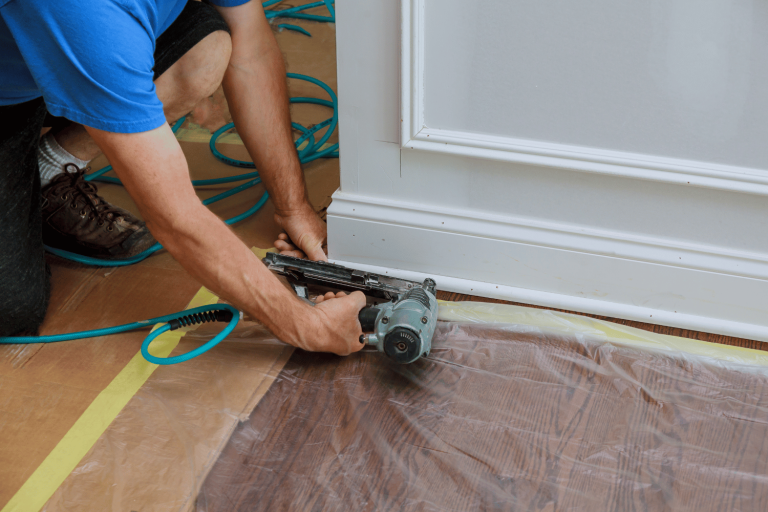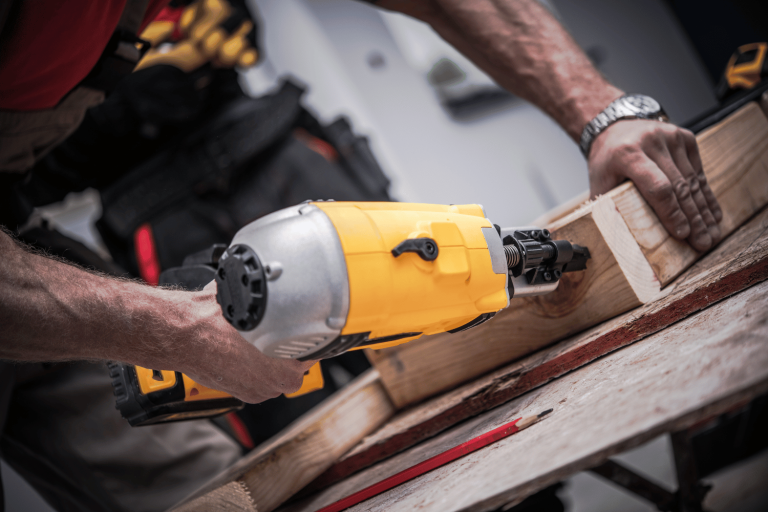Best Framing Nailer to Finish Framing Faster
Who doesn’t want to finish their framing project faster?
If you’re fed up with dealing with those pesky hammer-and-nail combos, it may be time for an upgrade.
A superior tool will drastically reduce the amount of time it takes to complete a framing job and make your life infinitely easier – all you need to do is find the right framing nailer!
But since there are so many options available out there, how can you differentiate between models that’ll get the job done quickly and efficiently versus ones better left on the store shelf?
Don’t worry – we got your back!
Keep reading for our guide on finding the best framing nailer for DIYers and professionals alike.
How We Choose the Best Framing Nailers
Well, let me tell you, choosing the best framing nailers for this article was no small feat.
We dove deep into the nailer market, sifting through countless models and brands, all while avoiding the dreaded carpenter bee who seemed to have taken a liking to our office space.
We looked at features like power, precision, ease of use, and of course, style (we’re not just looking for a workhorse, we want a good-looking one too!).
We also consulted with expert carpenters and contractors, who gave us the lowdown on what they look for in a framing nailer.
After much deliberation, we landed on these beauties of the framing nailer world.
These nailers are the real deal, and we can’t wait to share our findings with you.
So buckle up, because it’s time to nail it like a boss!
Overall Winner – Best Framing Nailer
BOSTITCH Framing Nailer, Round Head, 1-1/2-Inch to 3-1/2-Inch, Pneumatic (F21PL)

Key Features
- 1,050 inch pounds of driving power
- Accepts 1-1/2″ to 3-1/2″ framing nails
- 21° magazine
Why It’s a Great Choice
For those DIYers and professionals that need to handle the toughest jobs, BOSTITCH has got your back with their Framing Nailer!
This 21-degree framing nail gun is lightweight, yet powerful enough to deliver excellent performance in a variety of applications.
With its patented push button adjustable depth guide, you can make sure you always drive nails to the desired depth.
Plus, this durable magnesium design includes two quick change nosepieces so you can easily convert the tool to either framing or metal connector applications—two nailers in one!
Its adjustable rafter hook provides a simple but effective way to hang the tool on joists and rafters.
So whether you’re working on the toughest projects or just deciding where your artwork should go, BOSTITCH’s Framing Nailer will hit it out of the park every time!
Best Cordless Framing Nailer
Milwaukee M18 FUEL 21-Degree Framing Nailer (2744-20)
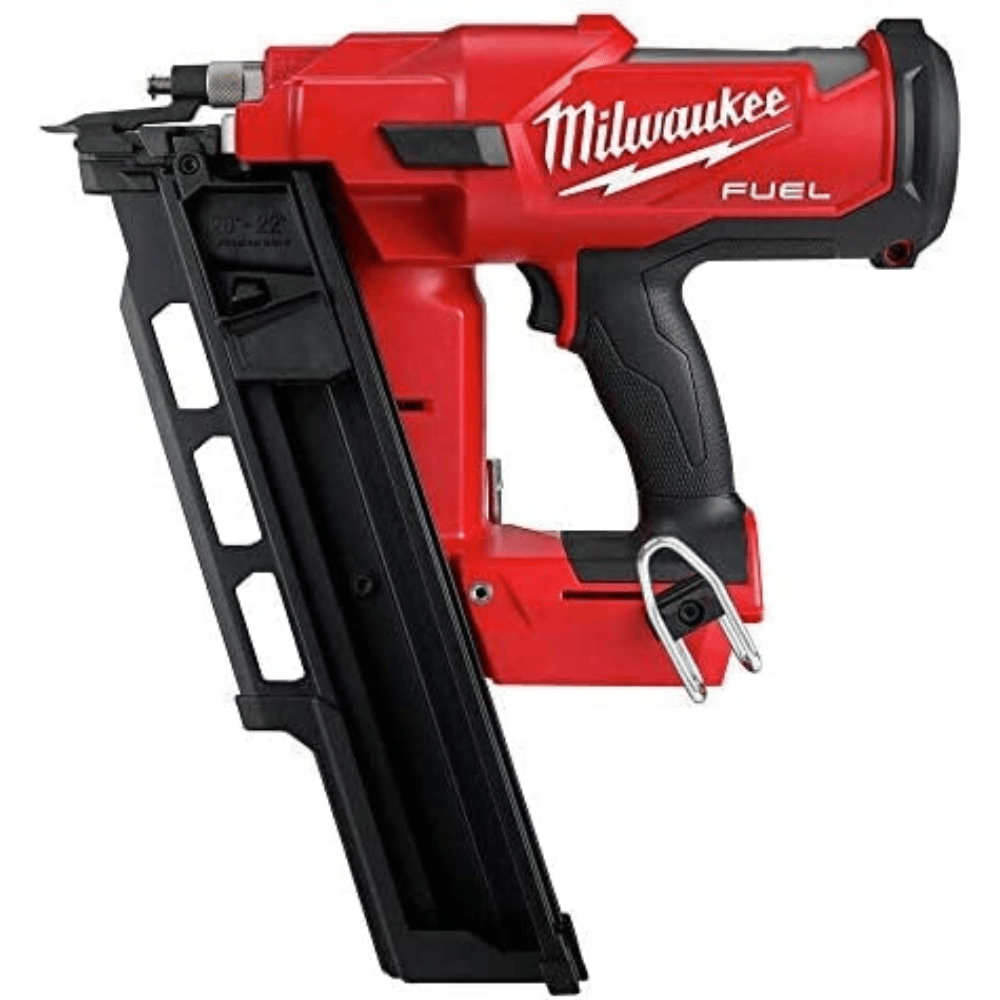
Key Features
- Drives 750 nails per charge
- Accepts 2″ to 3-1/2″ round head framing nails
- Fires up to 3 nails per second
Why It’s a Great Choice
Introducing the Milwaukee M18 FUEL 21-Degree Framing Nailer – when precision and speed are essential.
With this powerful nailer, you can easily drive 2-3 ½” full round-head framing nails into engineered lumbers with effortless efficiency.
No oiling or maintenance required – and no smelly gas cartridges either!
Plus, you won’t have to wait for your tool to build up pressure; this fantastic nailer is ready to go from the get-go with no ramp-up time.
Choose from two firing modes – sequential and contact actuation (bump fire) – for your exact needs.
Best of all, you get pneumatic speed performance with up to three nails per second, plus a mighty 750 nails per M18XC 5 Ah battery charge!
Time to take on a DIY project like a pro?
The Milwaukee M18 FUEL 21-Degree Framing Nailer is the perfect pick!
Best Lightweight Framing Nailer
Paslode Pneumatic Framing Nailer F325R, 513000

Key Features
- 30° magazine with quick 2-step reloading
- Accepts 2″ to 3-1/4″ framing nails
- 5.9 lbs and less than 12″ long
Why It’s a Great Choice
Get the Paslode Framing Nailer and build with confidence.
When it comes to lightweight tools, this hammering powerhouse won’t weigh you down.
At only 5.9 lbs, you’ll be comfortable while tackling overhead or tight spaces projects.
Make your next job a breeze with the great maneuverability of this pneumatic framing nail gun which easily fits between 16″ on center studs.
Plus, you’ll work faster than ever with a bypass follower that provides quick 2-step reloading.
And don’t forget about fewer misfires and jams when you use 30° Paslode framing nails!
For the DIYers and professional builders out there, trust the Paslode Framing Nailer to get the job done efficiently, conveniently, and reliably!
Best Framing Nailer on a Budget
NuMax SFR2190 Pneumatic 21 Degree 3-1/2″ Framing Nailer
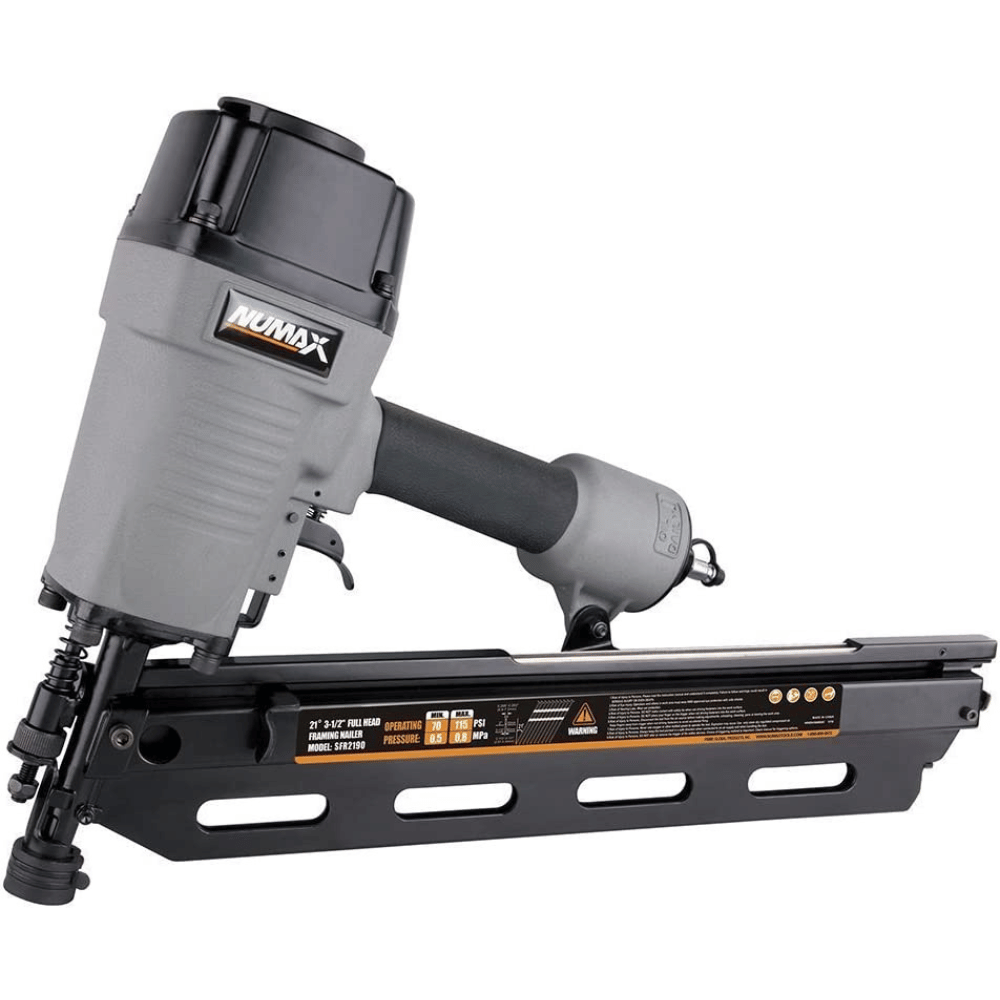
Key Features
- Anti-dry-fire mechanism
- Accepts 2″ to 3-1/2″ framing nails
- 360-degree adjustable exhaust
Why It’s a Great Choice
The NuMax Framing Nailer is the pinnacle of versatility and convenience.
Built with hardened steel, you can expect a durable pneumatic tool that won’t give up on you before the job is done.
The Anti-Dry-Fire Mechanism ensures that empty fires are a thing of the past, reducing damage and increasing accuracy in your work each time.
The Dual Mode Trigger gives you control to switch from single sequential firings to bump firing power depending on what the project requires — so if speed is essential one second and precision the next, you’ll have the ability to handle both with ease!
For projects using different materials and approaches, take advantage of its Tool-Free Depth Adjustment Wheel which lets you easily adjust driving depths by hand in just seconds.
And saving best for last: your masterpiece won’t be marred by pesky scrapes thanks to its No-Mar Safety Tip.
DIYers and professionals alike will appreciate how this one tool can save time, material costs, and effort while delivering top-notch results every time!
Best Framing Nailer for Professionals
Metabo HPT Framing Nailer (NR83A5)
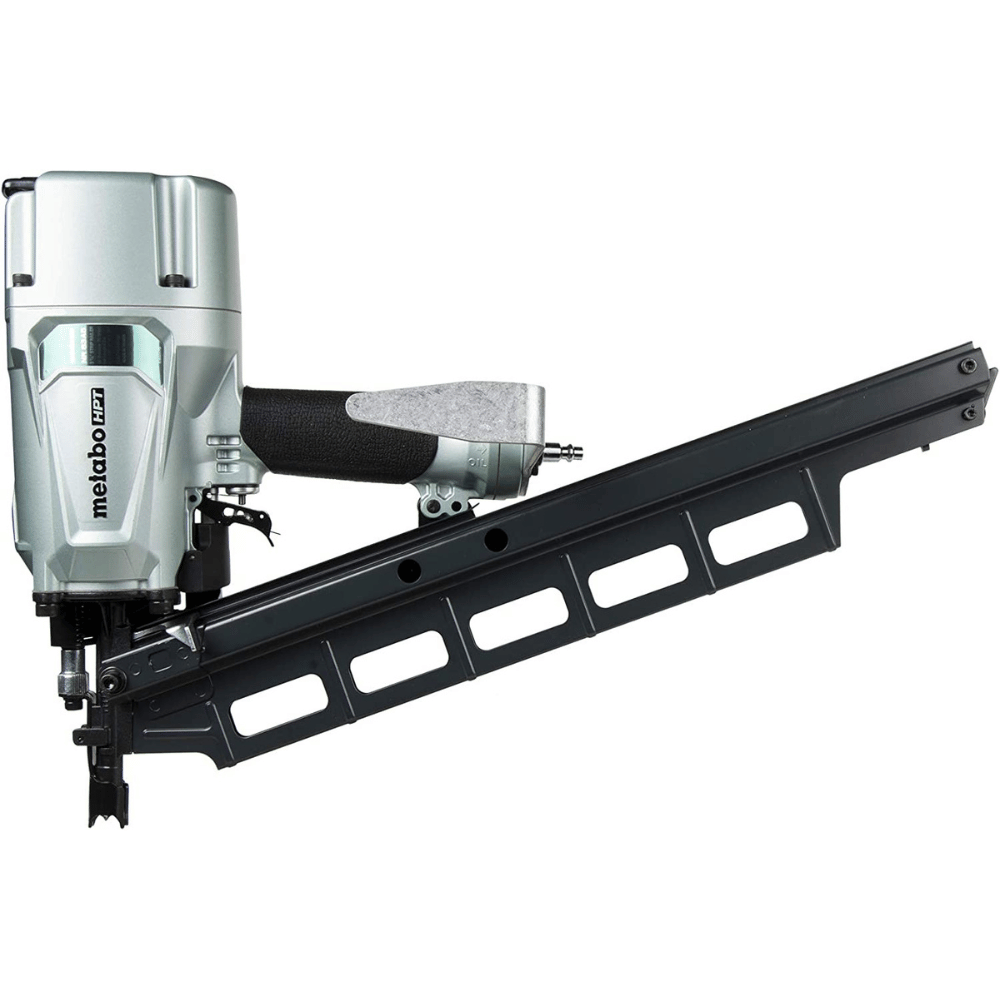
Key Features
- 21° magazine
- Accepts 2″ to 3-1/4″ framing nails
- Sequential and contact nailing modes
Why It’s a Great Choice
Are you ready to take your hammer and nail to the next level?
Take on any job with this pneumatic nailer!
This Metabo framing nailer features a cylinder valve drive system that gives you superior performance and increased longevity.
And when you’re nailing it to the wall, you don’t have to worry about precision or accuracy – just choose between sequential or contact nailing with the selective actuation trigger, adjust the depth of drive for improved control, and hammer away without breaking a sweat!
Plus, this lightweight and well-balanced tool accepts two strips of 2″ – 3-1/4″, 21° round head, plastic collated strip nails, so whatever your project is, this nailer has got your back.
And for extra comfort, there’s even an ergonomic non-slip rubber grip on the handle so it won’t slip away from you during use.
So go ahead – DIYers and professionals alike can bring their projects to life with the Metabo HPT Framing Nailer!
What are you waiting for?
Get hammering!
Buyer’s Guide to the Best Framing Nailers
Framing nailers may seem like a pretty straightforward tool, but trust us, we’ve seen some wild questions come our way.
That’s why we’re introducing this FAQ section, where we’ll tackle all your burning questions about framing nailers.
So put down that hammer and join us as we delve into the wonderful world of framing nailers.
What is a framing nailer?
A framing nailer is a power tool used to drive nails into wood to frame or construct walls, floors, and roofs. It is a handheld tool that uses compressed air, electricity, or fuel to drive nails into wood quickly and efficiently, saving time and effort compared to using a hammer and nails. Framing nailers come in various types, sizes, and styles, and are commonly used by carpenters, contractors, and DIY enthusiasts for building structures and projects that require a strong and secure frame.
How do you use a framing nailer?
Using a framing nailer requires some basic safety precautions and knowledge of the tool’s features. Here are the general steps for using a framing nailer:
- Put on safety glasses and ear protection.
- Load nails into the nail magazine of the framing nailer.
- Connect the framing nailer to an air compressor or power source.
- Adjust the depth of the nail to ensure proper penetration.
- Hold the framing nailer firmly against the surface where the nail will be driven.
- Position the nailer at a 90-degree angle to the surface and pull the trigger to drive the nail.
- Repeat the process until all necessary nails have been driven.
- Disconnect the framing nailer from the power source and unload any remaining nails from the magazine.
It’s important to always read and follow the manufacturer’s instructions for your specific framing nailer model.
What are the different types of framing nailers?
There are three main types of framing nailers: pneumatic, cordless, and fuel-powered.
- Pneumatic framing nailers are powered by an air compressor and use compressed air to drive nails into wood. They are known for their power, speed, and accuracy.
- Cordless framing nailers are powered by a rechargeable battery and offer greater portability and convenience compared to pneumatic models. They are also quieter and produce no exhaust.
- Fuel-powered framing nailers use a combination of compressed air and fuel cells to drive nails into wood. They are highly portable and can be used in areas without access to electricity.
Additionally, framing nailers can be classified by the type of nails they drive, such as clipped head or round head nails. The type of nailer you choose will depend on your specific needs and preferences.v
Are pneumatic framing nailers better than cordless framing nailers?
Whether pneumatic or cordless framing nailers are better depends on your specific needs and preferences.
Pneumatic framing nailers are powered by compressed air and require an air compressor to operate. They are typically more powerful than cordless nailers, allowing you to drive nails into tough materials with ease. They are also generally more affordable than cordless nailers, making them a popular choice among DIYers and professionals alike.
Cordless framing nailers, on the other hand, are powered by rechargeable batteries and are more portable than pneumatic nailers. They offer greater freedom of movement and flexibility on the job site, as you don’t need to worry about being tethered to an air compressor. They are typically lighter and easier to maneuver, making them a good choice for overhead work or in tight spaces.
When deciding which type of framing nailer is best for you, consider factors such as the size and scope of your project, your level of experience, and your budget. If you’re working on a large-scale framing project that requires a lot of power, a pneumatic nailer may be the better choice. If you’re working in a smaller space or need greater portability, a cordless nailer may be the way to go. Ultimately, it’s important to choose the framing nailer that best suits your specific needs and preferences.
What is a coil framing nailer?
A coil framing nailer is a type of framing nailer that uses coiled nails instead of individual, collated nails. The coiled nails are held together by a wire or plastic strip, similar to collated nails, but are wound into a compact coil instead of a straight strip.
Coil framing nailers are designed to hold a larger quantity of nails than other types of nailers, allowing for longer periods of uninterrupted work. The coiled nails are fed through a tube or channel in the nailer, with the coil feeding forward as nails are used.
Coil framing nailers are typically used for large-scale framing and construction projects, such as building homes, commercial buildings, or other large structures. They are compatible with a range of nail sizes and materials, including steel and galvanized finishes, and are available in both pneumatic and cordless models.
What are the benefits of using a framing nailer?
Using a framing nailer offers several benefits compared to traditional hammer and nails. Here are some of the main advantages:
- Saves time and effort: A framing nailer can drive nails into wood quickly and efficiently, saving time and effort compared to hammering nails by hand.
- Increased accuracy: Framing nailers are designed to drive nails precisely and accurately, reducing the likelihood of bending or breaking nails.
- Enhanced safety: Using a framing nailer reduces the risk of injury from hammering nails, as well as from flying nail fragments.
- Increased productivity: With a framing nailer, you can work faster and complete projects more quickly, increasing productivity and efficiency.
- Versatility: Framing nailers can be used for a variety of projects beyond framing, such as roofing, siding, and decking.
- Improved quality: Using a framing nailer can result in a more secure and stable structure, as nails are driven in with greater force and accuracy.
Overall, a framing nailer can be a valuable tool for carpenters, contractors, and DIY enthusiasts looking to increase their productivity and achieve better results in their projects.
What is the difference between a clipped head and a round head framing nailer?
The difference between a clipped head and a round head framing nailer is in the type of nails they drive and their degree of holding power.
- Clipped head framing nailers: These nailers use nails that have a clipped head, meaning that a portion of the head is removed to allow for a greater number of nails to fit in the magazine. Clipped head nails are preferred by some contractors because they take up less space in the nailer’s magazine, allowing for more nails to be loaded. However, some building codes do not allow the use of clipped head nails due to their reduced holding power.
- Round head framing nailers: These nailers use nails with a full, round head that provides a greater degree of holding power than clipped head nails. Round head nails are typically required by building codes for structural framing applications, such as wall framing, roof decking, and floor sheathing.
In summary, the main difference between clipped head and round head framing nailers is the type of nails they use and the degree of holding power those nails provide.
What size nail should I use with my framing nailer?
The size of nails you should use with your framing nailer will depend on the specific model and type of nailer you have, as well as the type of wood you are nailing into. Generally, framing nailers use nails that range in size from 2 inches to 3.5 inches in length, with common sizes including 2.5 inches and 3 inches.
When choosing the size of nails to use, consider the thickness and density of the wood you will be nailing into. Thicker or denser wood may require longer or thicker nails for a secure hold. It’s also important to follow any manufacturer recommendations for nail size and type to ensure safe and effective use of your framing nailer.
Always check the packaging or labeling of your nails to ensure they are compatible with your framing nailer model and intended use. If in doubt, consult the manufacturer’s instructions or consult a professional for guidance.
What angle is the best for a framing nailer?
The angle of a framing nailer refers to the angle of the magazine that holds the nails. Framing nailers are typically available in two angles: 21 degrees and 30 degrees.
Both angles have their advantages and disadvantages, and the best angle for your framing nailer will depend on your specific needs and preferences.
Here are some factors to consider when choosing the angle of your framing nailer:
- Maneuverability: A 21-degree framing nailer typically has a more compact design, making it easier to maneuver in tight spaces.
- Capacity: A 30-degree framing nailer can typically hold more nails in its magazine, allowing you to work longer without reloading.
- Cost: 21-degree framing nailers tend to be less expensive than 30-degree models.
- Compatibility: Check the type of nails that are compatible with your framing nailer, as some models may only work with specific angles.
Ultimately, the best angle for your framing nailer will depend on your specific needs and the type of work you will be doing. Consider your budget, the size of your project, and your personal preferences when choosing the angle of your framing nailer.
Can I adjust the depth of the nail with my framing nailer?
Yes, most framing nailers allow you to adjust the depth of the nail, which can be useful for achieving the proper hold and avoiding overdriving or underdriving the nail.
Most framing nailers have a depth adjustment mechanism that allows you to set the depth of the nail before firing. This mechanism can typically be adjusted by turning a dial or knob on the nailer, or by using a tool to adjust the depth setting.
To adjust the depth of the nail, start by firing a test nail into a scrap piece of wood. Check the depth of the nail and adjust the depth setting as needed until you achieve the desired hold. Repeat this process as needed throughout your project to ensure consistent and accurate nail depth.
Always follow the manufacturer’s instructions for adjusting the depth of your framing nailer, and wear appropriate safety gear, such as safety glasses and ear protection, when operating the nailer.
What types of nails are compatible with a framing nailer?
Framing nailers are designed to work with specific types and sizes of nails. The most common type of nails used with a framing nailer are called framing nails or common nails, which are available in a range of sizes and materials.
Here are some of the most common types of nails that are compatible with framing nailers:
- Collated framing nails: These are nails that are already collated in a strip or coil for easy loading into the nailer. They are available in a range of sizes, from 2 inches to 3.5 inches in length, and are typically made from steel.
- Smooth shank nails: These nails have a smooth shaft and are ideal for use in softwoods, such as pine and cedar.
- Ring shank nails: These nails have a ridged shaft that provides a better grip in hardwoods and other dense materials.
- Screw shank nails: These nails have a spiral thread along the shaft, which provides a stronger hold than smooth or ring shank nails.
When choosing nails for your framing nailer, it’s important to consider the type and thickness of the wood you will be nailing into, as well as the size and angle of your nailer. Always follow the manufacturer’s instructions for compatible nail sizes and types to ensure the safe and effective use of your framing nailer.
Choosing the Best Framing Nailer for You
Whether you are a weekend warrior or a full-fledged do-it-yourselfer, equipping yourself with the right tools is essential.
Don’t settle for anything less than these great framing nailers.
We did all the work so you don’t have to; trust us that these are the best of the best!
Now make your selection and give it a go – watch that project take shape without all the hassle.
Click on any of the links to check prices on Amazon and order yours now!


